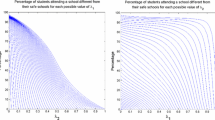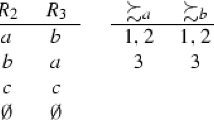Abstract
We consider school choice problems. We are interested in solutions that satisfy consistency. Consider a problem and a recommendation made by the solution for the problem. Suppose some students are removed with their positions in schools. Consider the “reduced” problem consisting of the remaining students and the remaining positions. Consistency states that in the reduced problem, the solution should assign each remaining student to the same school as initially. Neither the immediate acceptance rule (also known as the Boston mechanism) nor the top trading cycles rules is consistent. We show that the Pareto solution is the smallest consistent solution containing the immediate acceptance rule. It is also the smallest consistent solution containing the top trading cycles rule.
Similar content being viewed by others
Notes
Other rules have been defined for the school choice problem. A family of rules containing the deferred acceptance rule and the immediate acceptance rule has been defined (Chen and Kesten 2013). While in the deferred acceptance algorithm proposals are tentatively accepted at each step and confirmed only at the last step, in the immediate acceptance algorithm proposals accepted at each step are final. Each rule in the family is defined by an algorithm in which the proposals accepted at each step are final in the same step, or every two steps, and so on. A different version of the immediate acceptance rule has been introduced, the “immediate acceptance rule with skips” (Alcalde 1996; Harless 2014). For a detailed discussion, see Remark 3.1.
On the other hand, when a solution correspondence is not consistent, we might want to know how much we need to reduce it to obtain consistency. The maximal consistent subsolution is its largest consistent subsolution. This concept is well defined as long as the solution has at least one consistent subsolution (Thomson 1994).
The concept of a minimal consistent enlargement has been studied in several other models: Classical fair allocation problems (Thomson 1994), problems in which several objects and money are allocated among a group of people (Bevia 1996), abstract social choice problems (Yeh 2006), and roommates matching problems (Nizamogullari and Özkal-Sanver 2014b).
In mixed-ownership object allocation problems, the “you request my house-I get your turn” rule has been characterized on the basis of a list of axioms that includes consistency (Sönmez and Ünver 2010). For roommates problems, the core has been characterized on the basis of a list of axioms that includes consistency (Can and Klaus 2013), but there is essentially no consistent refinement of the core (Özkal-Sanver 2010).
The solution that recommends all the allocations in the core has been characterized on the basis of a list of axioms that includes consistency (Nizamogullari and Özkal-Sanver 2014a).
These results are the same in many-to-one problems, when preferences are strict and “responsive” (Toda 2006).
Even though we assume that the number of positions offered is greater than the number of students, the results hold even without the assumption. This assumption simplifies notation.
Note that each school has a positive capacity, i.e., for each \(c\in C'\), \(q_c>0\).
This rule is known in the literature as the Boston mechanism (Abdulkadiroğlu and Sönmez 2003). The name “immediate acceptance rule” reflects the fact that each acceptance is finalized at each step of the algorithm.
No two cycles intersect and since the students and schools are finite, there is always a cycle.
This result is model-free. We include the proof for the school-choice problem for completeness.
Formally, this partition depends on \(\mu \). To avoid unnecessary notation, we denote the partition as M.
For each s, we are not specifying the complete preference relation below “being unassigned”, \(\emptyset \). This is not a problem because the immediate acceptance rule does not take into account those schools.
I thank William Thomson for raising this question. Harless (2014) gives the name to the rule and compares the properties of this rule, the deferred acceptance rule, and the immediate acceptance rule.
The complete proof is available upon request.
For each \(\sigma \in \Sigma \), we are not specifying the complete preference relation below “being unassigned”, \(\emptyset \). This is not a problem because the top trading cycles rule does not take into account those schools.
For each \(c\in C\), we are not specifying the complete priority order. For this proof, it is not a problem.
For each \(\gamma _j\in \Gamma \), we are not specifying the complete priority order. For this proof, it is not a problem.
I thank William Thomson for raising this question.
The example in Proposition 3.2 shows this.
The complete proof is available upon request.
I thank an anonymous referee for raising this point.
References
Abdulkadiroğlu A, Pathak P, Roth A (2005a) The New York City high school match. Am Econ Rev Papers Proc 95(2):364–367
Abdulkadiroğlu A, Pathak P, Roth A, Sönmez T (2005b) The Boston public school match. Am Econ Rev Papers Proc 95(2):368–371
Abdulkadiroğlu A, Pathak P, Roth A, Sönmez T (2006) Changing the Boston school choice mechanism: Strategyproofness as equal access. Technical Report w11965, National Bureau of Economic Research
Abdulkadiroğlu A, Sönmez T (2003) School choice: a mechanism design approach. Am Econ Rev 93(3):729–746
Alcalde J (1996) Implementation of stable solutions to marriage problems. J Econ Theory 69(1):240–254
Bevia C (1996) Identical preferences lower bound solution and consistency in economies with indivisible goods. Soc Choice Welfare 13:113–126
Can B, Klaus B (2013) Consistency and population sensitivity properties in marriage and roommate markets. Soc Choice Welfare 41:835–862
Chen Y, Kesten O (2013) From Boston to Chinese parallel to deferred acceptance: theory and experiments on a family of school choice mechanisms. Mimeo
Davis M, Maschler M (1965) The kernel of a cooperative game. Naval Res Logist Quat 12:223–259
Ergin H (2002) Efficient resource allocation on the basis of priorities. Econometrica 70:2489–2497
Gale D, Shapley LS (1962) College admissions and the stability of marriage. Am Math Mon 69(1):9–15
Harsanyi J (1959) A bargaining model for the cooperative N-person games. In: Tucker AW, Luce R (eds) Contributions to the theory of games. Princeton University Press, Princeton, pp 324–358
Harsanyi J (1963) A simplified bargaining model for the N-person cooperative games. Int Econ Rev 4:194–220
Harless P (2014) “Immediate” acceptance in school choice: comparing implementations
Kesten O (2006) On two competing mechanisms for priority-based assignment problems. J Econ Theory 127:155–171
Kojima F, Ünver U (2014) The ”Boston” school-choice mechanism: an axiomatic approach. Econ Theory 55(3):515–544
Kumano T (2013) Strategy-proofness and stability of the Boston mechanism: an almost impossibility result. J Pub Econ 105:23–29
Nizamogullari D, Özkal-Sanver I (2014a) Characterization of the core in full domain marriage markets. Math Soc Sci 69:34–42
Nizamogullari D, Özkal-Sanver I (2014b) Consistent enlargements of the core in roommate problems. Mimeo
Özkal-Sanver I (2010) Impossibilities for roommate problems. Math Soc Sci 59(3):360–363
Pathak P (2011) The mechanism design approach to student assignment. Ann Rev Econ 3:513–536
Sasaki H, Toda M (1992) Consistency and characterization of the core of two-sided matching problems. J Econ Theory 56:218–227
Shapley L, Scarf H (1974) On cores and indivisibility. J Math Econ 1(1):23–37
Sönmez T, Ünver U (2010) House allocation with existing tenants: a characterization. Games Econ Behav 69(2):425–445
Thomson W (1988) A study of choice correspondences in economies with a variable number of agents. J Econ Theory 46:247–259
Thomson W (1990) The consistency principle. In: Ichiishi T, Neyman A, Tauman Y (eds) Game theory and applications. Academic Press, New York, pp 187–215
Thomson W (1994) Consistent extensions. Math Soc Sci 28(1):35–49
Thomson W (2014) Consistent allocation rules. Mimeo
Toda M (2006) Monotonicity and consistency in matching markets. Int J Game Theory 34:13–31
Yeh C-H (2006) Reduction-consistency in collective choice problems. J Math Econ 42:637–642
Young P (1987) On dividing an amount according to individual claims or liabilities. Math Oper Res 12:398–414
Young P (1988) Distributive justice in taxation. J Econ Theory 48:321–335
Author information
Authors and Affiliations
Corresponding author
Additional information
I thank William Thomson and Çağatay Kayı for detailed comments and discussions. I also thank two anonymous referees for their useful comments and suggestions.
Rights and permissions
About this article
Cite this article
Jaramillo, P. Minimal consistent enlargements of the immediate acceptance rule and the top trading cycles rule in school choice. Soc Choice Welf 48, 177–195 (2017). https://doi.org/10.1007/s00355-016-0954-3
Received:
Accepted:
Published:
Issue Date:
DOI: https://doi.org/10.1007/s00355-016-0954-3




